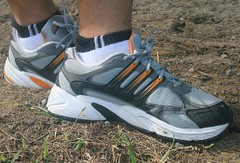Monocotyledonous plants and dicotyledonous plants are different in many ways. Knowing their differences is very important in your practical paper. The following figure shows five ways in which they are different:


They are different in terms of:
- The number of cotyledons in their seeds - A monocot has one cotyledon in their seeds whereas a dicot has two cotyeldons in their seeds.
- The arrangement of the veins in their leaves - The veins in the leaves of a monocot are usually parallel whereas those in the leaves of a dicot are netlike or branching (reticulated venation).

- The arrangement of the vascular bundles in their stems - In a monocot, the vascular bundles are usually randomly arranged whereas in a dicot, they are arranged in ring.

- The root systems - A monocot has fibrous root system whereas a dicot has a tap root system.

- The number of flower parts - The flower parts in a monocot are usually in a multiple of three whereas those in a dicot are in a multiple of four or five.
- The stomata in the leaves of a dicot leaf are mostly found on the lower surface of the leaf whereas those in the leaves of a monocot are evenly distributed on the lower and upper surfaces of the leaves.
